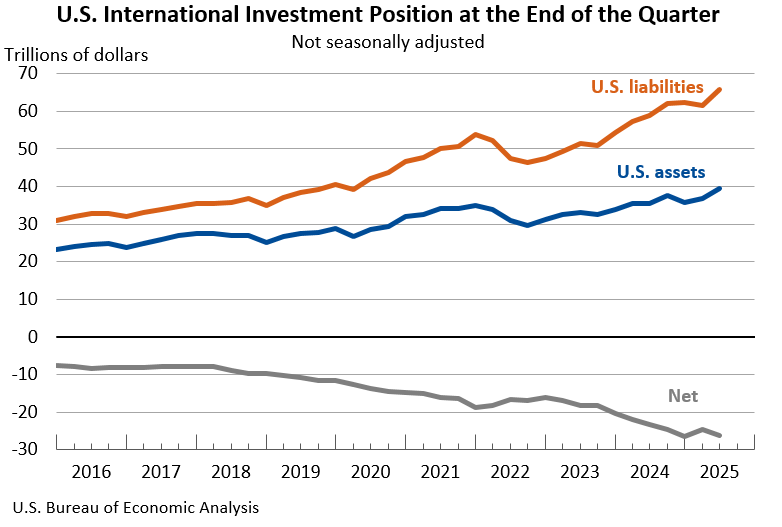Notice
Due to a lapse in appropriations, this website is not being updated.
Bureau of Economic Analysis
U.S. International Investment Position, 2nd Quarter 2025
The U.S. net international investment position, the difference between U.S. residents’ foreign financial assets and liabilities, was -$26.14 trillion at the end of the second quarter of 2025, according to statistics released today by the U.S. Bureau of Economic Analysis. Assets totaled $39.56 trillion, and liabilities were $65.71 trillion. At the end of the first quarter, the net investment position was -$24.65 trillion (revised).
Principal Federal Economic Indicators
Noteworthy
The Latest
Coming Soon: BEA to Release Prototype Statistics on the Economic Impact of Outdoor Recreation
The U.S. Bureau of Economic Analysis on Feb. 14 will release for the first time prototype statistics measuring the economic effects of outdoor recreation – pursuits like boating, RVing and snowboarding.
These prototype statistics covering 2012-2016 will be available in a news release and data tables posted on BEA’s website at 8:30 a.m. Eastern time.
Real Consumer Spending Rises in December
Personal income increased 0.4 percent in December after increasing 0.3 percent in November. Wages and salaries, the largest component of personal income, increased 0.5 percent in December after increasing 0.4 percent in November.
Personal Income and Outlays, December 2017
Personal income increased 0.4 percent in December after increasing 0.3 percent in November. Wages and salaries, the largest component of personal income, increased 0.5 percent in December after increasing 0.4 percent in November.
GDP Increases in Fourth Quarter
Real gross domestic product (GDP) increased 2.6 percent in the fourth quarter of 2017, according to the “advance” estimate released by the Bureau of Economic Analysis. In the third quarter, real GDP increased 3.2 percent.
Gross Domestic Product, 4th quarter and annual 2017 (advance estimate)
Real gross domestic product (GDP) increased 2.6 percent in the fourth quarter of 2017, according to the “advance” estimate released by the Bureau of Economic Analysis. In the third quarter, real GDP increased 3.2 percent.
Gross Domestic Product (GDP) by State: Third Quarter 2017
Real gross domestic product (GDP) increased in every state and the District of Columbia in the third quarter of 2017. Real GDP by state growth in the third quarter ranged from 5.7 percent in Delaware to 0.5 percent in South Dakota.
Gross Domestic Product by State, 3rd quarter 2017
Real gross domestic product (GDP) increased in every state and the District of Columbia in the third quarter of 2017, according to statistics on the geographic breakout of GDP released today by the U.S. Bureau of Economic Analysis. Real GDP by state growth in the third quarter ranged from 5.7 percent in Delaware to 0.5 percent in South Dakota (table 1).
Gross Domestic Product by Industry: Third Quarter 2017
Finance and insurance; durable goods manufacturing; and information services were the leading contributors to the increase in U.S. economic growth in the third quarter of 2017. Overall, 18 of 22 industry groups contributed to the 3.2 percent increase in real GDP in the third quarter.
Gross Domestic Product by Industry, 3rd quarter 2017
Finance and insurance; durable goods manufacturing; and information services were the leading contributors to the increase in U.S. economic growth in the third quarter of 2017. According to gross domestic product (GDP) by industry statistics released by the Bureau of Economic Analysis, 18 of 22 industry groups contributed to the overall 3.2 percent increase in real GDP in the third quarter.
U.S. International Trade in Goods and Services, November 2017
The U.S. monthly international trade deficit increased in November 2017 according to the U.S. Bureau of Economic Analysis and the U.S. Census Bureau. The deficit increased from $48.9 billion in October (revised) to $50.5 billion in November, as imports increased more than exports.




